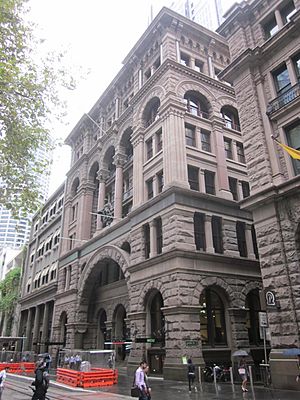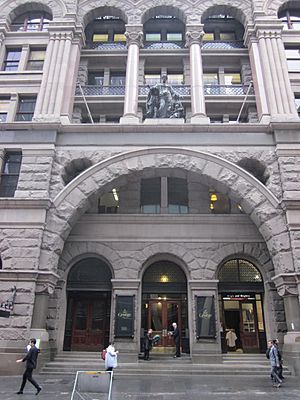348-352 George Street, Sydney facts for kids
Quick facts for kids 348-352 George Street |
|
|---|---|

348-352 George Street, Sydney, New South Wales
|
|
| Location | 348 - 352 George Street, Sydney central business district, City of Sydney, New South Wales, Australia |
| Built | 1894 |
| Architect | Edward Raht |
| Architectural style(s) | Federation Romanesque |
| Official name: National Mutual Building (former); Society General Building; Societe Generale House; Equitable Building; 350 George | |
| Type | State heritage (built) |
| Designated | 2 April 1999 |
| Reference no. | 234 |
| Type | Insurance company/building |
| Category | Commercial |
| Builders | Hudson and Loveridge |
| Lua error in Module:Location_map at line 420: attempt to index field 'wikibase' (a nil value). | |
The building at 348-352 George Street, Sydney is a historic office building in the heart of Sydney, Australia. It is located on George Street in the Sydney central business district. This building was designed by Edward Raht and built by Hudson and Loveridge in 1894. It is also known by other names like the National Mutual Building (former) or 350 George Street, Sydney. This property is privately owned and is listed on the New South Wales State Heritage Register. This means it is protected because of its important history and unique design.
Contents
History of 348-352 George Street
The land where this building stands has been used since the early days of the colony. In the 1880s, there were different shops here, including a famous music store. In 1890, a big American insurance company, The Equitable Life Assurance Society, bought the land. They tore down the old buildings to build their new office.
The company sent their architect, Edward Raht, from New York to design the building. Raht was known for designing grand buildings for banks and insurance companies. He designed this office building with a new idea: a strong steel frame inside. The outside was covered with heavy stone called trachyte. This stone came from quarries in Bowral.
What made this building special was that its entire outside was made of trachyte. Usually, trachyte was only used for parts of buildings. This was one of the first buildings in Australia to use it so much. The building was finished in 1894. It was an early example of the American Romanesque style in Australia. This style was made popular by another American architect, Henry Hobson Richardson. The building also shows how big American companies started to expand into Australia a long time ago. Edward Raht also designed other buildings in Australia, including one in Melbourne.
A Place for Women's Voices
Around 1898, an important Australian woman named Maybanke Anderson had an office in this building. She was a pioneer for women's rights and a strong supporter of women being able to vote. Her office was on the third floor. From here, she ran her journal called The Woman's Voice.
In April 1898, Maybanke Anderson also started a group called the Women's Federal League. This group was created to encourage women to get involved in politics. At that time, women in New South Wales could not vote. So, the League's goal was to get women to encourage the men in their families to support the idea of Federation. Federation was about uniting the Australian colonies into one country.
Maybanke Anderson sent out letters from her office. She asked women to join the League and form local groups. She hoped these groups would visit people and encourage men to vote for Federation in the upcoming referendum. Even though she worked very hard, it's not clear how much the League helped. The referendum in 1898 did not get enough votes for Federation. The League seemed to fade away after that. Later, other women's groups were formed to support Federation, but they were not connected to Maybanke Anderson's League.
After the Equitable Life Assurance Society, the building became home to other insurance companies.
What the Building Looks Like
The building at 348-352 George Street has six floors and a basement. It shows many features of the Federation Romanesque style. This style often uses rough-faced stone and large, rounded arches.
The outside walls on George Street and Angel Place are made of heavy, rough blocks of trachyte and marble. These were put together by the stone company Hudson and Loveridge. The main entrance on George Street is very grand. It has a huge arch that spans about 13 meters. Each stone block in this arch weighs three tons!
Inside, the building has an early example of a steel frame structure. This means the inside weight is held up by steel, while the outside walls also help support the building. There is a tall, open space inside called an atrium. The main stairs and lobbies are built around this atrium. The floors and ceilings in the atrium are made of marble slabs supported by steel frames. The atrium also has a beautiful ceiling made of colored glass and fancy bronze decorations.
The building still uses its original old-style lifts, but they are now in modern enclosures. This building looks similar to the nearby ANZ Bank, which was also designed by Edward Raht.
Why it is a Heritage Site
The building at 348-352 George Street is very important for several reasons:
- It is a great example of the Federation Romanesque style of architecture. It was one of the first buildings in Australia to show this American style.
- It is linked to the American architect Edward Raht, who brought this style to Australia.
- It was one of the first buildings to have its entire outside made of trachyte stone.
- It shows how building techniques from overseas were used in Australia around the year 1900.
- It represents how big American companies expanded into Australia in the late 1800s.
- It is important because it was the office of Maybanke Anderson. She was a pioneer for women's rights and started the Women's Federation League from here. This group was the first to specifically encourage women to take an active role in the Federation campaign in New South Wales.
- The building has a remarkable steel-framed atrium and beautiful details made of marble, plaster, steel, bronze, and glass.
- It adds a lot to the look of George Street and Martin Place.
348-352 George Street was officially listed on the New South Wales State Heritage Register on 2 April 1999.


